- Wondering how to get Monopoly GO! free rolls? Well, you’ve come to the right place. In this guide, we provide you with a bunch of tips and tricks to get some free rolls for the hit new mobile game. We’ll …
Best Roblox Horror Games to Play Right Now – Updated Weekly
By Adele Wilson
Our Best Roblox Horror Games guide features the scariest and most creative experiences to play right now on the platform!The BEST Roblox Games of The Week – Games You Need To Play!
By Sho Roberts
Our feature shares our pick for the Best Roblox Games of the week! With our feature, we guarantee you'll find something new to play!Type Soul Clan Rarity Guide – All Legendary And Common Clans Listed!
By Nathan Ball
Wondering what your odds of rolling a particular Clan are? Wonder no more, with my handy Type Soul Clan Rarity guide.
Finger Tied Jr. – Redesigning Finger Tied for the iPhone
In the fall of 2012 I released a game for the iPad called Finger Tied. Finger Tied is a puzzle game where you have to move your fingers to fill in shapes on the screen while keeping up to four fingers touching the screen at all times. It’s kind of like Twister for your fingers.
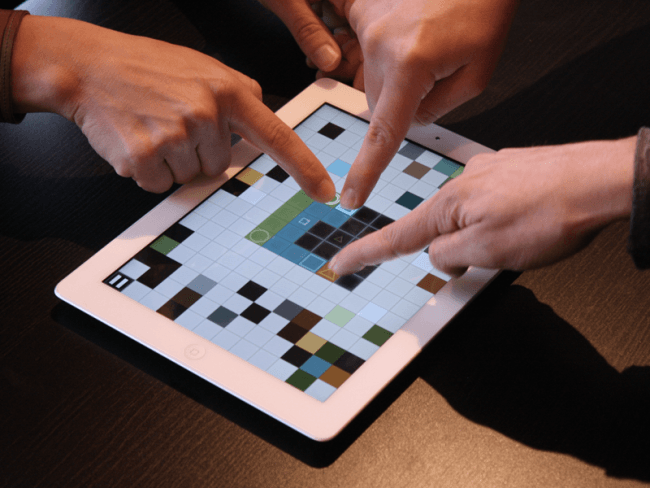
In the fall of 2012 I released a game for the iPad called Finger Tied. Finger Tied is a puzzle game where you have to move your fingers to fill in shapes on the screen while keeping up to four fingers touching the screen at all times. It’s kind of like Twister for your fingers.
The game made use of the large screen and multitouch capabilities of the iPad to provide a game experience that couldn’t have existed on computers before multitouch screens existed. The game was intended to be played either by yourself, or as a party game with up to four people all playing together on one iPad.
Finger Tied was released to a lot of critical acclaim, and even Apple picked it as one of their “New Ways to Play” in their “Best of the App Store” list for 2012. However, many people wrote to me and asked if I was going to release a version for iPhone or iPod touch. It seemed like something I could do, so soon after I released the iPad version I started working on a version for iPhone to be called Finger Tied Jr. (since it would be on a smaller screen). I thought that I might be able to make an iPhone version in a week or two and release it while there was still some buzz around the iPad version of the game.
I knew that making the game work on the iPhone was going to be challenging. On the iPad, each square in the game was designed to be a specific size to make moving your fingers around the screen possible without being too frustrating. The iPad’s screen also allowed me to create a play area that was 12 squares by 12 squares large. In order to keep the squares the same size on the iPhone, I would only have a 5 by 6 play area available. It’s also important to note that the pixels on the iPhone screen are smaller than on the iPad. So a 64 by 64 pixel square on the iPhone is slightly smaller than on the iPad.
But undaunted, off I went and started working. The first thing I needed to do was redesign the entire user interface to work on the iPhone. Some of the menus, like the main menu, would work just by reducing the size of the buttons. But others, like the puzzle select menus, would need to be redesigned completely to work well on the smaller screen. After I had enough of the user interface converted that I could get into the game and also use the puzzle editor, I was able to start making some puzzles.
Creating a puzzle game is only half about designing the rules of the game and making it work. The other half is creating all the puzzles, playing them all, removing half the puzzles, balancing the difficulty, playing them all again, and repeating the process over and over. In the end, you’re trying to create a flow to the game that’s fun for the player. Early puzzles need to teach the player how to play the game. Then puzzles need to get more difficult as the game progresses without becoming too frustrating.
I hesitate to use the word narrative in this sense, but the design of the flow of the puzzles adds an authorial voice to a puzzle game. It is through the puzzles that the player learns what the game is, and what I, the game maker, wanted to show them with it.
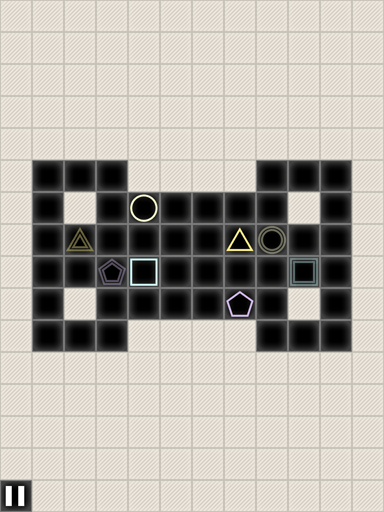
In making (reordering, scrapping, and remaking) the puzzles for the iPad version of the game, I had learned a set of guidelines that I found made certain kinds of puzzles fun to play. For example, I found that placing a puzzle that featured asymmetry after several symmetrical puzzles created a nice moment of surprise, as it forced the player to think differently all of a sudden. I also liked puzzles that forced you to interlock your fingers. Or puzzles that forced all your fingers to end up very close together with your hands in odd positions. With that in mind, I created about 30 puzzles for Finger Tied Jr. based on what I had learned in making the iPad version’s puzzles. And then I played them. And they weren’t fun.
I thought that maybe it was just that I was too close to the game. I’d been working on Finger Tied for six months by this point. Maybe I was just too involved with the game to see the fun in what I’d done. I sent this early iPhone version to some fellow developer friends to get some much needed feedback. I got comments like “It’s not bad,” or “Neat.” Ouch. This is what other developers tell you when your game isn’t working, but they don’t want to hurt your feelings.
I tinkered with it a bit more, but the more I played with it, the more I became convinced that it just wasn’t possible to make the game work on the iPhone. So I gave up and I started adding new features, like the puzzle sharing system, to the iPad version of the game instead. When that was done, I put Finger Tied aside.
By the spring, I was now working with Matt Rix (Trainyard) on a new game called Snow Siege. By this time, I had long since given up on Finger Tied Jr. So when I was out with friends, I’d started pulling out my iPhone to show them my failed attempt at making a version Finger Tied for iPhone. The strange thing was, people kept saying “this could be really fun.”
In April, I decided to come back to Finger Tied Jr. to see if I could bring some fresh perspective to the game. I picked up the project where I left off and started playing the levels I’d created six months earlier. People were right, there was the potential for fun, it just wasn’t there yet, and I started to wonder why. I began by thinking about what made the puzzles in Finger Tied for iPad fun. That’s when I realized that many of the things that made the iPad puzzles fun were the same things that made the puzzles frustrating on the iPhone. Things like squeezing a bunch of fingers into a small space was fun on the iPad, but anger-inducing on the phone. I realized that I needed to think about the puzzle design completely differently.
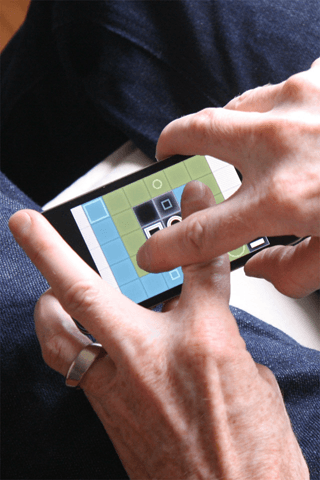
I went back to the level editor and started creating new puzzles. I created dozens of new puzzles trying all kinds of new things to see what worked and what didn’t. Then I played through them again and again. Then I cut two thirds of the puzzles out. What was left formed the basis for the puzzles in Finger Tied Jr. The puzzles that were left defined a new set of guidelines for puzzles that were fun on the iPhone. Puzzles that could be played on the 5 by 6 grid. Puzzles that were fun on a small screen with very slightly smaller squares.
For example, some of these new guidelines were:
- don’t get too many fingers too close together. While fun on the larger screen of the iPad, this just causes frustration on the smaller iPhone screen.
- turning the iPhone while doing a puzzle is easier than the iPad, so make use of spinning the device to complete a level more often.
- make use of one or two finger puzzles more often, as they’re more interesting to play when holding the iPhone in your hands.
- if two fingers need to move along paths that are next to each other, offset their starting positions so that the fingers have room to move.
- it’s fun to have two versions the same version of a puzzle that must be played in completely different ways, one obvious, and one not.
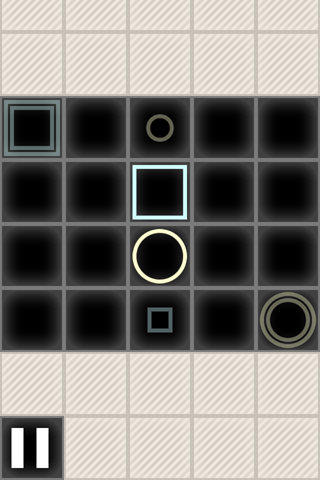
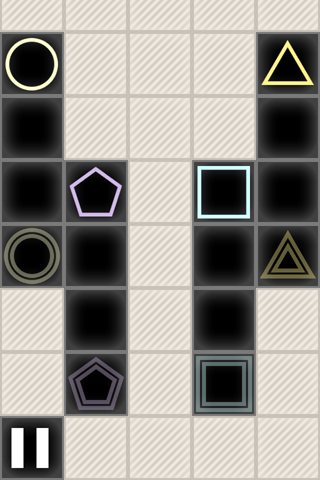
And so I went back through the process of creating levels, balancing, reordering, throwing out, and repeating. When I was finished, I sent out another build to some developer friends, and this time I got the comments I was hoping for; that the puzzles worked on the iPhone. That the game was fun!
All told, Finger Tied Jr. took about five weeks of effort, spread out over six months. I’m extremely happy with how the game turned out. It feels like a new game to me. I wasn’t able to get it out in time to capitalize on the buzz around the iPad version of the game, but the game redesign required the time and perspective I gained from setting it aside. Because after all, approaching a problem from a new perspective is one of the best things that puzzle games can teach us.
Finger Tied Jr. is available on the iPhone App Store for $0.99.
Owen Goss is the founder of Streaming Colour Studios and creator of Finger Tied, and Co-Founder of Milkbag Games. Owen has been making games for over nine years. He started in the AAA console industry, but has been making games as an independent developer for the past five years. He lives and works in Guelph, Ontario, Canada.
More articles...
Monopoly GO! Free Rolls – Links For Free Dice
By Glen Fox
Wondering how to get Monopoly GO! free rolls? Well, you’ve come to the right place. In this guide, we provide you with a bunch of tips and tricks to get some free rolls for the hit new mobile game. We’ll …Best Roblox Horror Games to Play Right Now – Updated Weekly
By Adele Wilson
Our Best Roblox Horror Games guide features the scariest and most creative experiences to play right now on the platform!The BEST Roblox Games of The Week – Games You Need To Play!
By Sho Roberts
Our feature shares our pick for the Best Roblox Games of the week! With our feature, we guarantee you'll find something new to play!Type Soul Clan Rarity Guide – All Legendary And Common Clans Listed!
By Nathan Ball
Wondering what your odds of rolling a particular Clan are? Wonder no more, with my handy Type Soul Clan Rarity guide.







